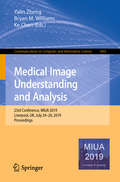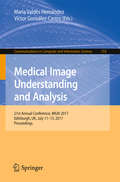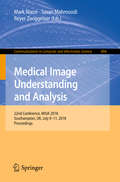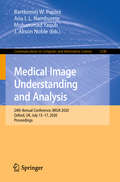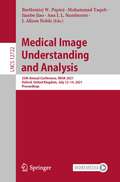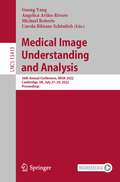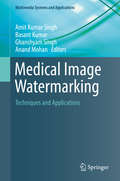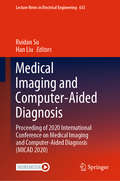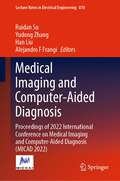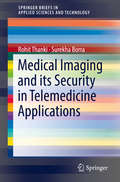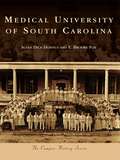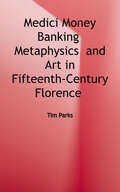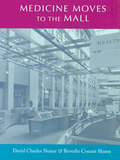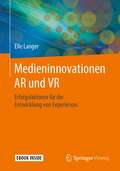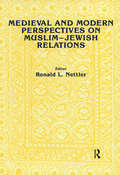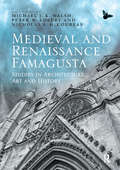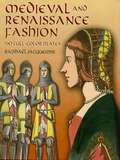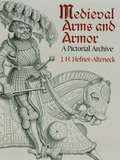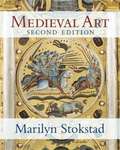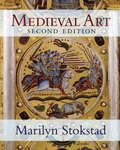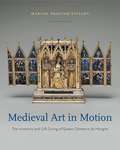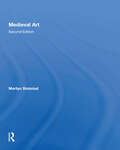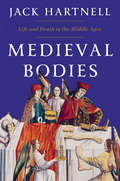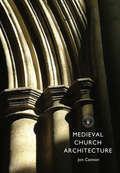- Table View
- List View
Medical Image Understanding and Analysis: 23rd Conference, MIUA 2019, Liverpool, UK, July 24–26, 2019, Proceedings (Communications in Computer and Information Science #1065)
by Ke Chen Yalin Zheng Bryan M. WilliamsThis book constitutes the refereed proceedings of the 23rd Conference on Medical Image Understanding and Analysis, MIUA 2019, held in Liverpool, UK, in July 2019. The 43 full papers presented were carefully reviewed and selected from 70 submissions. There were organized in topical sections named: oncology and tumour imaging; lesion, wound and ulcer analysis; biostatistics; fetal imaging; enhancement and reconstruction; diagnosis, classification and treatment; vessel and nerve analysis; image registration; image segmentation; ophthalmic imaging; and posters.
Medical Image Understanding and Analysis: 21st Annual Conference, MIUA 2017, Edinburgh, UK, July 11–13, 2017, Proceedings (Communications in Computer and Information Science #723)
by Víctor González-Castro María Valdés HernándezThis book constitutes the refereed proceedings of the 21st Annual Conference on Medical Image Understanding and Analysis, MIUA 2017, held in Edinburgh, UK, in July 2017.The 82 revised full papers presented were carefully reviewed and selected from 105 submissions. The papers are organized in topical sections on retinal imaging, ultrasound imaging, cardiovascular imaging, oncology imaging, mammography image analysis, image enhancement and alignment, modeling and segmentation of preclinical, body and histological imaging, feature detection and classification.The chapters 'Model-Based Correction of Segmentation Errors in Digitised Histological Images' and 'Unsupervised Superpixel-Based Segmentation of Histopathological Images with Consensus Clustering' are open access under a CC BY 4.0 license.
Medical Image Understanding and Analysis: 22nd Conference, Miua 2018, Southampton, Uk, July 9-11, 2018, Revised Selected Papers (Communications In Computer And Information Science #894)
by Mark Nixon Sasan Mahmoodi Reyer ZwiggelaarThis book constitutes the refereed proceedings of the 22st Annual Conference on Medical Image Understanding and Analysis, MIUA 2018, held in Southampton, UK, in July 2018.The 34 revised full papers presented were carefully reviewed and selected from 49 submissions. The papers are organized in topical sections on liver analysis, medical image analysis, texture and image analysis, MRI: applications and techniques, segmentation in medical images, CT: learning and planning, ocular imaging analysis, applications of medical image analysis.
Medical Image Understanding and Analysis: 24th Annual Conference, MIUA 2020, Oxford, UK, July 15-17, 2020, Proceedings (Communications in Computer and Information Science #1248)
by Bartłomiej W. Papież Ana I. L. Namburete Mohammad Yaqub J. Alison NobleThis book constitutes the refereed proceedings of the 24th Conference on Medical Image Understanding and Analysis, MIUA 2020, held in July 2020. Due to COVID-19 pandemic the conference was held virtually. The 29 full papers and 5 short papers presented were carefully reviewed and selected from 70 submissions. They were organized according to following topical sections: image segmentation; image registration, reconstruction and enhancement; radiomics, predictive models, and quantitative imaging biomarkers; ocular imaging analysis; biomedical simulation and modelling.
Medical Image Understanding and Analysis: 25th Annual Conference, MIUA 2021, Oxford, United Kingdom, July 12–14, 2021, Proceedings (Lecture Notes in Computer Science #12722)
by Bartłomiej W. Papież Mohammad Yaqub Jianbo Jiao Ana I. L. Namburete J. Alison NobleThis book constitutes the refereed proceedings of the 25th Conference on Medical Image Understanding and Analysis, MIUA 2021, held in July 2021. Due to COVID-19 pandemic the conference was held virtually. The 32 full papers and 8 short papers presented were carefully reviewed and selected from 77 submissions. They were organized according to following topical sections: biomarker detection; image registration, and reconstruction; image segmentation; generative models, biomedical simulation and modelling; classification; image enhancement, quality assessment, and data privacy; radiomics, predictive models, and quantitative imaging.
Medical Image Understanding and Analysis: 26th Annual Conference, MIUA 2022, Cambridge, UK, July 27–29, 2022, Proceedings (Lecture Notes in Computer Science #13413)
by Guang Yang Angelica Aviles-Rivero Michael Roberts Carola-Bibiane SchönliebThis book constitutes the refereed proceedings of the 26th Conference on Medical Image Understanding and Analysis, MIUA 2022, held in Cambridge, UK, in July 2022. The 65 full papers presented were carefully reviewed and selected from 95 submissions. They were organized according to following topical sections: biomarker detection; image registration, and reconstruction; image segmentation; generative models, biomedical simulation and modelling; classification; image enhancement, quality assessment, and data privacy; radiomics, predictive models, and quantitative imaging.Chapter “FCN-Transformer Feature Fusion for Polyp Segmentation” is available open access under a Creative Commons Attribution 4.0 International License via link.springer.com.
Medical Image Watermarking
by Amit Kumar Singh Basant Kumar Ghanshyam Singh Anand MohanThis book presents medical image watermarking techniques and algorithms for telemedicine and other emerging applications. This book emphasizes on medical image watermarking to ensure the authenticity of transmitted medical information. It begins with an introduction of digital watermarking, important characteristics, novel applications, different watermarking attacks and standard benchmark tools. This book also covers spatial and transform domain medical image watermarking techniques and their merits and limitations. The authors have developed improved/novel watermarking techniques for telemedicine applications that offer higher robustness, better perceptual quality and increased embedding capacity and secure watermark. The suggested methods may find potential applications in the prevention of patient identity theft and health data management issues which is a growing concern in telemedicine applications. This book provides a sound platform for understanding the medical image watermarking paradigm for researchers in the field and advanced-level students. Industry professionals working in this field, as well as other emerging applications demanding robust and secure watermarking will find this book useful as a reference.
Medical Imaging and Computer-Aided Diagnosis: Proceeding of 2020 International Conference on Medical Imaging and Computer-Aided Diagnosis (MICAD 2020) (Lecture Notes in Electrical Engineering #633)
by Han Liu Ruidan SuThis book covers virtually all aspects of image formation in medical imaging, including systems based on ionizing radiation (x-rays, gamma rays) and non-ionizing techniques (ultrasound, optical, thermal, magnetic resonance, and magnetic particle imaging) alike. In addition, it discusses the development and application of computer-aided detection and diagnosis (CAD) systems in medical imaging. Given its coverage, the book provides both a forum and valuable resource for researchers involved in image formation, experimental methods, image performance, segmentation, pattern recognition, feature extraction, classifier design, machine learning / deep learning, radiomics, CAD workstation design, human–computer interaction, databases, and performance evaluation.
Medical Imaging and Computer-Aided Diagnosis: Proceedings of 2022 International Conference on Medical Imaging and Computer-Aided Diagnosis (MICAD 2022) (Lecture Notes in Electrical Engineering #810)
by Ruidan Su Yudong Zhang Han Liu Alejandro F FrangiThis book covers virtually all aspects of image formation in medical imaging, including systems based on ionizing radiation (x-rays, gamma rays) and non-ionizing techniques (ultrasound, optical, thermal, magnetic resonance, and magnetic particle imaging) alike. In addition, it discusses the development and application of computer-aided detection and diagnosis (CAD) systems in medical imaging. Given its coverage, the book provides both a forum and valuable resource for researchers involved in image formation, experimental methods, image performance, segmentation, pattern recognition, feature extraction, classifier design, machine learning / deep learning, radiomics, CAD workstation design, human–computer interaction, databases, and performance evaluation.
Medical Imaging and its Security in Telemedicine Applications (SpringerBriefs in Applied Sciences and Technology)
by Rohit Thanki Surekha BorraThis book introduces medical imaging, its security requirements, and various security mechanisms using data hiding approaches. The book in particular provides medical data hiding techniques using various advanced image transforms and encryption methods. The book focuses on two types of data hiding techniques: steganography and watermarking for medical images. The authors show how these techniques are used for security and integrity verification of medical images and designed for various types of medical images such as grayscale image and color image. The implementation of techniques are done using discrete cosine transform (DCT), discrete wavelet transform (DWT), singular value decomposition (SVD), redundant DWT (RDWT), fast discrete curvelet transform (FDCuT), finite ridgelet transform (FRT) and non-subsampled contourlet transform (NSCT). The results of these techniques are also demonstrated after description of each technique. Finally, some future research directions are provided for security of medical images in telemedicine application.
Medical University of South Carolina, The (Campus History)
by E. Brooke Fox Susan Dick HoffiusThe Medical University of South Carolina, founded in Charleston in 1824 by the Medical Society of South Carolina, consists of six colleges, each with its own rich history. The College of Medicine was the tenth medical school in the country and the first medical school in the Deep South. Its graduates fought and healed during times of war, tended to the injured after hurricanes and earthquakes, and battled epidemic diseases that swept through the South. The College of Nursing and the College of Pharmacy were established within years of each other at the close of the 19th century. The College of Graduate Studies, the College of Dental Medicine, and the College of Health Professions were established in the latter half of the 20th century to fill some of the state's most crucial medical needs. Over the years, the Medical University of South Carolina has educated thousands of doctors, nurses, pharmacists, dentists, and other health care workers and scientists.
Medici Money: Banking, Metaphysics, and Art in Fifteenth-Century Florence
by Tim ParksBefore they achieved renown as patrons of the arts and de facto rulers of Florence, the Medici family earned their fortune in banking. But even at the height of the Renaissance, charging interest of any kind meant running afoul of the Catholic Church's ban on usury. <p><p>Tim Parks reveals how the legendary Medicis—Cosimo and Lorenzo "the Magnificent" in particular—used the diplomatic, military, and even metaphysical tools at hand, along with a healthy dose of intrigue and wit, to further their fortunes as well as their family's standing.
Medicine Moves to the Mall (Center Books on Space, Place, and Time)
by David Charles Sloane Beverlie Conant SloaneThe shopping mall seems an unlikely place to go for health care services. Yet, the mall has become home to such services as well as a model for redesigning other health care facilities. In Medicine Moves to the Mall, David Charles Sloane and Beverlie Conant Sloane document the historical changes to our health care landscape by exploring the interactions between medicine and place. This unique combination of architectural history and the history of medicine provides a thought-provoking analysis of the geography of the practice of medicine.The book presents three essays, each accompanied by a gallery of historical and recent photos. The authors discuss the rise of modern hospitals and how they were shaped into scientifically sterile and humanly stark "medical workshops." Starting in the 1970s, hospital facilities were altered in appearance to become more friendly and welcoming. The integration of a shopping mall's spaciousness and open design with technology and scientific innovation served in "humanizing the hospital." Most recently, the accessibility and convenience of shopping center and roadside clinics have invited Americans to go "shopping for health" in the increasingly commercialized medical system.Medicine Moves to the Mall will appeal to scholars and professionals in fields ranging from health care to cultural geography and from urban studies to architectural history, as well as to readers interested in the shifting status of medicine in American society.
Medieninnovationen AR und VR: Erfolgsfaktoren für die Entwicklung von Experiences
by Elle LangerAugmented und Virtual Reality sind Medieninnovationen mit spezifischen Merkmalen. Sie erzeugen beim Nutzer eine Immersion, da der Nutzer in das Medium und seine 360° Umgebung hineintaucht. Um erfolgreich Inhalte und Anwendungen für AR und VR zu entwickeln, müssen psychologische Wirkungsweisen, die Besonderheiten der 360° Umgebung, die Geschichte und die Art der Mediennutzug mit den Bedürfnissen und Erlebnissen des Nutzers abgestimmt werden. Contentproduzenten stellt das vor neuartige Herausforderungen bei der Contententwicklung, der Methodenwahl, der Teamarbeit und dem gesamten Herstellungsprozess von AR und VR Experiences.Das Buch führt den Leser in die Merkmale der immersiven Medien ein und bietet ihm wissenschaftliche Belege und praxisrelevante Tipps, die ihm helfen, hochwertige und nutzerzentrierte Inhalte für die Immersiven Medien zu produzieren. Die wissenschaftlich hergeleiteten Erfolgsfaktoren in Form von Checklisten sind ein Leitfaden und eine ideale Grundlage, um den Herstellungsprozess zu standardisieren und die eigenen Projekte weiterzuentwickeln.
Medieval and Modern Perspectives on Muslim-Jewish Relations (Studies In Muslim-jewish Relations Ser. #Vol. 2.)
by Ronald L. NettlerFirst Published in 1995. The life of Jews in medieval Baghdad or 18th-century Tunis may now be considered to be important as Jewish life in 13th-century Worms or 19th-century Poland. Islamic theological and exegetical writing on Judaism may now command as much interest as their counterparts in Christian literature, while the rich Islamic-Jewish cultural interchange over many centuries is clearly of great significance. Studies in Muslim-Jewish Relations will be a series of general volumes each including a wide range of subjects, periodic edited volumes each focusing on a certain theme, and a planned related monograph series which will publish authored volumes on more specialized aspects of the field. This volume is a collection of twelve essays.
Medieval and Renaissance Famagusta: Studies in Architecture, Art and History
by Michael J. K. Walsh Peter W. Edbury Nicholas S. H. CoureasThere was a time seven centuries ago when Famagusta's wealth and renown could be compared to that of Venice or Constantinople. The Cathedral of St Nicholas in the main square of Famagusta, serving as the coronation place for the Crusader Kings of Jerusalem after the fall of Acre in 1291, symbolised both the sophistication and permanence of the French society that built it. From the port radiated impressive commercial activity with the major Mediterranean trade centres, generating legendary wealth, cosmopolitanism, and hedonism, unsurpassed in the Levant. These halcyon days were not to last, however, and a 15th century observer noted that, following the Genoese occupation of the city, 'a malignant devil has become jealous of Famagusta'. When Venice inherited the city, it reconstructed the defences and had some success in revitalising the city's economy. But the end for Venetian Famagusta came in dramatic fashion in 1571, following a year long siege by the Ottomans. Three centuries of neglect followed which, combined with earthquakes, plague and flooding, left the city in ruins. The essays collected in this book represent a major contribution to the study of Medieval and Renaissance Famagusta and its surviving art and architecture and also propose a series of strategies for preserving the city's heritage in the future. They will be of particular interest to students and scholars of Gothic, Byzantine and Renaissance art and architecture, and to those of the Crusades and the Latin East, as well as the Military Orders. After an introductory chapter surveying the history of Famagusta and its position in the cultural mosaic that is the Eastern Mediterranean, the opening section provides a series of insights into the history and historiography of the city. There follow chapters on the churches and their decoration, as well as the military architecture, while the final section looks at the history of conservation efforts and assesses the work that now needs to be done.
Medieval and Renaissance Fashion: 90 Full-Color Plates (Dover Pictorial Archive Ser.)
by Raphaël JacqueminKnights clad in chain mail populate these pages, alongside crowned heads in royal regalia and common folk in their finest apparel. Scrupulously authentic in every detail, these images offer colorful portraits that span centuries of fashion, from the Middle Ages through the Renaissance.Raphaël Jacquemin was preeminent among the fashion illustrators and historians of nineteenth-century Europe's golden age of fashion design publications. His 1869 Iconographie Générale et Méthodique du Costume du IV au XIX Siècle drew upon manuscripts, reliefs, and effigies from the Louvre, university libraries, and other archives for the most striking and accurate fashion statements from the fourth through seventeenth centuries. This collection features ninety of Jacquemin's magnificent hand-colored engravings, a gallery of iconic portraits that have served as museum exhibits in their own right. Fashion designers, artists, costumers, and others seeking authenticity of period detail—as well as inspiration for contemporary styles—will find this book a splendid resource.
Medieval Arms and Armor: A Pictorial Archive
by J. H. Hefner-AlteneckA renowned 19th-century cultural historian and specialist on the Middle Ages, J. H. Hefner-Alteneck spent much of his life observing the influence of art on many aspects of human life, including weaponry. His illustrations for this handsome archive — drawn with incredible exactitude — depict a wide array of medieval weapons and armor dating from the early ninth century to the mid-1700s.Adapted primarily from decorative ornamentation on burial monuments and manuscripts, hundreds of finely executed images depict authentic shields, swords, crossbows, helmets, and highly ornate suits of body armor for knights and their steeds. Newly translated descriptive notes, extracted from the original German text, identify the subjects. First published more than 100 years ago, this meticulously rendered study remains an invaluable source of permission-free illustrations for artists and designers and an indispensable reference for scholars, collectors, and hobbyists.
Medieval Art
by Marilyn StokstadThis beautifully produced survey of over a thousand years of Western art and architecture introduces the reader to a vast period of history ranging from ancient Rome to the age of exploration. The monumental arts and the diverse minor arts of the Middle Ages are presented here within the social, religious, and political frameworks of lands as varied as France and Denmark, Spain and Turkey. Marilyn Stokstad also teaches her reader how to look at medieval art-which aspects of architecture, sculpture, or painting are important and for what reasons. Stylistic and iconographic issues and themes are thoroughly addressed with attention paid to aesthetic and social contexts. Significantly updated, this second edition of Medieval Art spans the period from the second to the fifteenth centuries.
Medieval Art: Medieval Art (Icon Editions)
by Marilyn StokstadThis beautifully produced survey of over a thousand years of Western art and architecture introduces the reader to a vast period of history ranging from ancient Rome to the age of exploration. The monumental arts and the diverse minor arts of the Middle Ages are presented here within the social, religious, and political frameworks of lands as varied as France and Denmark, Spain and Turkey. Marilyn Stokstad also teaches her reader how to look at medieval art-which aspects of architecture, sculpture, or painting are important and for what reasons. Stylistic and iconographic issues and themes are thoroughly addressed with attention paid to aesthetic and social contexts. Significantly updated, this second edition of Medieval Art spans the period from the second to the fifteenth centuries and includes over 4000 illustrations, over 100 in color, detailed maps, a time-line, glossary, bibliography, and index-all in a larger 8 by 10 inch trim size.
Medieval Art in Motion: The Inventory and Gift Giving of Queen Clémence de Hongrie
by Mariah Proctor-TiffanyIn this visually rich volume, Mariah Proctor-Tiffany reconstructs the art collection and material culture of the fourteenth-century French queen Clémence de Hongrie, illuminating the way the royal widow gave objects as part of a deliberate strategy to create a lasting legacy for herself and her family in medieval Paris.After the sudden death of her husband, King Louis X, and the loss of her promised income, young Clémence fought for her high social status by harnessing the visual power of possessions, displaying them, and offering her luxurious objects as gifts. Clémence adeptly performed the role of queen, making a powerful argument for her place at court and her income as she adorned her body, the altars of her chapels, and her dining tables with sculptures, paintings, extravagant textiles, manuscripts, and jewelry—the exclusive accoutrements of royalty. Proctor-Tiffany analyzes the queen’s collection, maps the geographic trajectories of her gifts of art, and interprets Clémence’s generosity using anthropological theories of exchange and gift giving. Engaging with the art inventory of a medieval French woman, this lavishly illustrated microhistory sheds light on the material and social culture of the late Middle Ages. Scholars and students of medieval art, women’s studies, digital mapping, and the anthropology of ritual and gift giving especially will welcome Proctor-Tiffany’s meticulous research.
Medieval Art in Motion: The Inventory and Gift Giving of Queen Clémence de Hongrie
by Mariah Proctor-TiffanyIn this visually rich volume, Mariah Proctor-Tiffany reconstructs the art collection and material culture of the fourteenth-century French queen Clémence de Hongrie, illuminating the way the royal widow gave objects as part of a deliberate strategy to create a lasting legacy for herself and her family in medieval Paris.After the sudden death of her husband, King Louis X, and the loss of her promised income, young Clémence fought for her high social status by harnessing the visual power of possessions, displaying them, and offering her luxurious objects as gifts. Clémence adeptly performed the role of queen, making a powerful argument for her place at court and her income as she adorned her body, the altars of her chapels, and her dining tables with sculptures, paintings, extravagant textiles, manuscripts, and jewelry—the exclusive accoutrements of royalty. Proctor-Tiffany analyzes the queen’s collection, maps the geographic trajectories of her gifts of art, and interprets Clémence’s generosity using anthropological theories of exchange and gift giving. Engaging with the art inventory of a medieval French woman, this lavishly illustrated microhistory sheds light on the material and social culture of the late Middle Ages. Scholars and students of medieval art, women’s studies, digital mapping, and the anthropology of ritual and gift giving especially will welcome Proctor-Tiffany’s meticulous research.
Medieval Art Second Edition
by Marilyn StokstadThis beautifully produced survey of over a thousand years of Western art and architecture introduces the reader to a vast period of history ranging from ancient Rome to the age of exploration. The monumental arts and the diverse minor arts of the Middle Ages are presented here within the social, religious, and political frameworks of lands as varied as France and Denmark, Spain and Turkey. Marilyn Stokstad also teaches her reader how to look at medieval art-which aspects of architecture, sculpture, or painting are important and for what reasons. Stylistic and iconographic issues and themes are thoroughly addressed with attention paid to aesthetic and social contexts.
Medieval Bodies: Life And Death In The Middle Ages (Wellcome Collection)
by Jack HartnellWith wit, wisdom, and a sharp scalpel, Jack Hartnell dissects the medieval body and offers a remedy to our preconceptions. Just like us, medieval men and women worried about growing old, got blisters and indigestion, fell in love, and had children. And yet their lives were full of miraculous and richly metaphorical experiences radically different from our own, unfolding in a world where deadly wounds might be healed overnight by divine intervention, or where the heart of a king, plucked from his corpse, could be held aloft as a powerful symbol of political rule. In this richly illustrated and unusual history, Jack Hartnell uncovers the fascinating ways in which people thought about, explored, and experienced their physical selves in the Middle Ages, from Constantinople to Cairo and Canterbury. Unfolding like a medieval pageant, and filled with saints, soldiers, caliphs, queens, monks and monstrous beasts, this book throws light on the medieval body from head to toe—revealing the surprisingly sophisticated medical knowledge of the time. Bringing together medicine, art, music, politics, philosophy, religion, and social history, Hartnell's work is an excellent guide to what life was really like for the men and women who lived and died in the Middle Ages. Perfumed and decorated with gold, fetishized or tortured, powerful even beyond death, these medieval bodies are not passive and buried away; they can still teach us what it means to be human. Some images in this ebook are not displayed due to permissions issues.
Medieval Church Architecture
by Jon CannonBy the end of the medieval period, Britain's churches already had an architectural heritage of one thousand years, much of which remains on view today. This guide by architectural historian Jon Cannon uses high-quality photographs and diagrams to help us to analyze the leading changes in style from the Anglo-Saxon period, through the Romanesque as far as Gothic and Perpendicular. By identifying various clues left by each period, he enables us to date architectural features and styles, and explains the technical terms applied to them. If you have ever wondered how your church or cathedral developed, and want to know your triforium from your blind arcade or your vault from your hammerbeam, all the answers are here.
